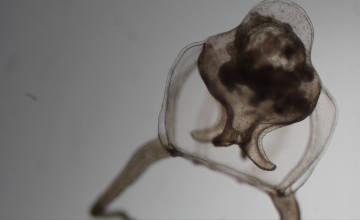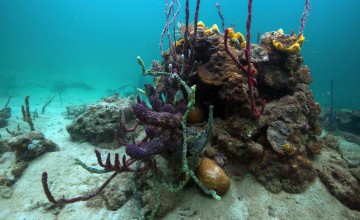
Rachel
Collin
Modern life is challenging – We document the physical conditions in the tropics and study how organisms, communities, and social-ecological systems respond to environmental adversity like heatwaves and hypoxia in our changing world
Research Focus
In the Collin Lab we work to understand how environmental conditions, their natural variation and environmental change from the climate emergency shape marine ecosystems and biodiversity. Our current work focuses on three areas (1) Documenting the biodiversity of tropical marine invertebrates, (2) Understanding mangrove ecosystems and blue carbon and (3) Stressors like hypoxia and pollution in tropical estuaries. We focus on seasonal variation in environmental conditions associated with terrestrial dry season and marine upwelling in the Bay of Panama (Pacific) and seasonal development of a low-oxygen water layer in Bocas del Toro (Caribbean). In these systems we seek to understand how how environmental conditions impact biodiversity, the timing and success of reproduction, larval and seedling growth and survival, and successful recruitment of the next generation.
As Director of STRI’S Bocas Del Toro Research Station, I work to promote understanding of the environment and biodiversity of the Bocas region. Part of this effort includes my collaboration with other taxonomists from around the world to develop tools to improve access to taxonomic tools including methods for observing and identifying marine invertebrates.
Additional links
Contact
Research Overview
Can larvae help us discover hidden diversity?
It is relatively easy to survey large animals that live on the seafloor but it’s not so simple to survey very small animals that live below scuba diving depths or that live buried deep in the sediment. However, many of these organisms produce free-living planktonic larvae that live in the water. Surveys and DNA barcoding of planktonic larvae in temperature oceans often recover species that have never been sampled as adults. This approach has not been used before in the tropics. The Collin lab team has been using DNA and morphological descriptions to document the larval diversity of Panama and link larvae to their adults.
How can we preserve, foster, and grow taxonomic expertise?
Taxonomy — the science of finding, describing and naming organisms — is vital to all biological research, especially to understanding and conserving biodiversity. The shortage of taxonomic expertise relative to the large number of undescribed or undiscovered taxa (the so-called taxonomic impediment) is one of the current challenges facing researchers engaged in identifying, classifying and conserving the world’s biodiversity. My goal is to promote species-level and revisionary taxonomic research and taxonomic training to overcome this challenge for tropical marine invertebrates. To do this, I have developed, in collaboration with other taxonomists, the Training in Tropical Taxonomy program. This program supports two graduate-level courses each year on the taxonomy of groups for which expertise is in particular short supply. Combined with the development of online resources such as how-to videos, glossaries of technical terms, translation tables, keys and species inventories, this supports the growth of the next generation of taxonomists and fosters international information transfer. Learn more at the Bocas ARTS website.
How do heat and hypoxia make dead zones?
Bahia Almirante is subject to seasonal hypoxia (low oxygen) that sometimes results in die-offs in marine life. We have been working to model the bay to understand how the physical conditions result in hot and hypoxic water in the back of the bay. This involves combining meteorological data, hydrology and physical oceanography. Long-term monitoring shows how the conditions vary and our experimental work with corals, sea urchins, and other marine invertebrates show how these animals respond to extreme conditions. Using this approach we can predict how the distributions of different species are limited by hot and hypoxic conditions.
How do Mangroves Capture Carbon?
Coastal swamps and mangroves sequester massive amounts of carbon in their soils. Yet the full extent of these carbon stores are yet to be mapped. Understanding the stability of these carbon stores and the mechanisms by which carbon is sequestered and released is vital for understanding how mangroves can contribute to climate mitigation efforts. The world is moving towards monetizing blue carbon, yet, we still lack data on the amount of carbon stored and the dynamics of this carbon, especially in the tropics.
The Collin Lab is working to help measure how much carbon is held in Panama's mangrove ecosystems. We are embarking on projects to understand the role of environmental conditions and invertebrate diversity in the blue carbon cycle.
Education
2002 Ph.D., University of Chicago, Committee on Evolutionary Biology
1996 M.Sc. University of Washington Department of Zoology
1993 Sc.B. Aquatic Biology, Brown University; Magna cum Laude and departmental honors.
Selected Publications
Collin, R., M. Madrid, D.E. Venera-Pontón, K. S. Macdonald, A. de Leon, D. Vrdoljak, M. J. Boyle, P. Bryant, T. Arehart, and A. C. Driskell. 2023. Diversity and Genetic
Connectivity of Atlantid Gastropods in the Tropical Eastern Pacific. Invertebrate Biology. 142: e12395
Maslakova S. C.I. Ellison, T. C. Hiebert, F. Conable, M.C. Heaphy, D. E. Venera-Pontón, J. L. Norenburg, M. L. Schwartz, N. D. Moss, M. J. Boyle, A. C. Driskell, K. S. Macdonald III, E.E. Zattara, R. Collin. 2022. Sampling multiple life stages significantly increases estimates of biodiversity. Royal Society Letters. 18 (4), 20210596.
Collin, R., Rebolledo A., Smith, E. and K.Y.K. Chan. 2021. Thermal tolerance of early development predicts the realized thermal niche of marine ecotherms. Functional Ecology. DOI: 10.1111/1365-2435.13850
Collin, R., S. Fredericq, D. W. Freshwater, E. Gilbert, M. Madrid, S. Maslakova, M. P. Miglietta, R. Rocha, E. Rodriguez, R. W. Thacker. 2016. TaxaGloss - A glossary and translation tool for biodiversity studies. Biodiversity Data Journal 4: e10732. doi: 10.3897/BDJ.4.e10732
Collin, R and K.Y.K. Chan. 2016. The sea urchin Lytechinus variegatus lives close to the upper thermal limit for early development in a tropical lagoon. Ecology and Evolution. 6: 5623-5634. doi:10.1002/ece3.2317
Carrillo-Baltodano A. and R. Collin. 2015. Crepidula slipper limpets alter sex change in response to physical contact with conspecifics. Biological Bulletin. 229:232-242.
Collin, R. 2013. Phylogenetic patterns and phenotypic plasticity of molluscan sexual systems. Integrative and Comparative Biology. 53: 723-735. doi: 10.1093/icb/ict076
Collin, R. 2012. Temperature-mediated trade-offs in the life histories of two slipper limpets (Gastropoda: Calyptraeidae) with planktotrophic development. Biological Journal of the Linnean Society. 106: 763-775.
Collin, R. and M. Miglietta. 2008. Reversing opinions on Dollo's Law. Trends in Ecology and Evolution. 23: 602-609.
Collin, R. 2004. The loss of complex characters, phylogenetic effects, and the evolution of development in a family of marine gastropods. Evolution. 58 (7): 1488-1502.
Collin, R. 2001. The effects of mode of development on phylogeography and population structure of North Atlantic Crepidula (Gastropoda: Calyptraeidae). Molecular Ecology. 10: 2249-2262.


